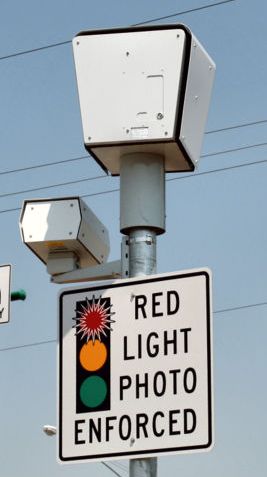Illinois State Sen. Dan Duffy may not get his wish for a complete ban on red-light cameras in Illinois, but he says “there’s more than one way to skin a cat.”
A special subcommittee on red-light cameras met Tuesday evening and heard testimony on both sides of the issue. Many citizens and experts, including the Illinois Policy Institute, spoke out against the cameras. Law enforcement representatives spoke in favor. In the end, a “shell bill” was passed out of committee:
A shell bill or vehicle bill is essentially a blank bill passed out of committee that allows lawmakers the flexibility of cobbling together a coherent bill, without the pressure of legislative deadline. In this particular case, because there were a total of five bills containing RLC [red-light camera] reforms, senators will have to work together to find agreement on a single, comprehensive bill on this issue.
What measures might make it into the shell bill?
The next step for anti-red light camera activists is to push legislators to include any and every measures possible that improve safety and decrease red light running. This includes mandating an increase in yellow light timing to 4 or 4.5 seconds, increasing the use of an [all] red interval, and eliminating RLC enforcement [for] right turns on red.
Short yellow-light intervals create what is known as a “dilemma zone.” The driver is too close to the intersection to stop without slamming on the brakes, but too far from the intersection to make it through before the light turns red. By increasing the yellow-light interval, the “dilemma zone” can be eliminated. This change in itself lowers the number of red-light running violations by giving motorists ample warning to stop. Some cities with red-light cameras have been caught deliberately shortening the yellow-light interval (or varying it) in order to induce more tickets. In Peoria, the yellow-light interval is three to four seconds, depending on the size of the intersection according to Public Works Director David Barber.
An all-red interval is the period of time that traffic traveling in all directions have a red light. In other words, once a light changes to red, the cross-traffic doesn’t immediately get a green. There’s usually a one- to two-second delay during which all lights are red before the the cross-traffic light turns green. This allows more time for the intersection to clear before allowing cross-traffic to proceed, which improves safety. In Peoria, signalized intersections have a one-second all-red interval.
Turning right on red is legal at signalized intersections unless they have a red arrow or are otherwise posted with “no right on red” signs. Because of the geometry of the intersections, it’s often necessary to pull up past the stop line in order to see around traffic in the forward lanes. In communities that have red-light cameras, a lot of their revenue is generated by giving red-light citations to drivers who pull up in order to turn right on red in this way.
“We want to put in every reform possible,” says Scott Tucker, GOP nominee for state representative in the 11th district and organizer of a road trip of citizens to the hearings. “So many sensible reforms will kill the cameras over time because there will not be enough revenue to operate the cameras.”
In most cities (perhaps all–I haven’t done an exhaustive search), the police department doesn’t buy the red-light cameras, but instead contracts with a third-party vendor. The vendor installs and maintains the cameras, and in many municipalities, actually sends out the citations to violators. Other municipalities have an officer review the violations and send the citations out from the police department. The vendor gets a cut of the fines imposed on violators. If there are fewer violators, there will be less profit incentive for the vendors. And if that happens, you won’t need a ban on red-light cameras because simple economics will drive the vendors out of business.

 Peoria Police Chief Steven Settingsgaard says he’s not proposing red-light cameras as a way to bring more revenue into the city, but only as a way to improve safety because speeding is one of the most common
Peoria Police Chief Steven Settingsgaard says he’s not proposing red-light cameras as a way to bring more revenue into the city, but only as a way to improve safety because speeding is one of the most common